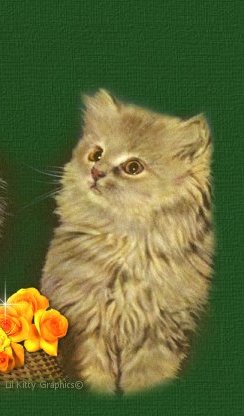|

 








Fall is for Planting
Meowmie likes to plant new perennials in the fall to
replace ones that did not do so well. Why Plant in
the Fall? You don't have to make excuses for
putting off planting until the weather cools down.
Fall is, in fact, an ideal time for both you and
your plants to get to work. For the same reasons
that you'd rather not be toiling away in the heat,
many plants would also prefer to get started in the
fall.The most important "job" for newly installed
plants is the establishment of a healthy, vigorous
root system. The period from fall to the first spring
is your plant's opportunity to increase this root
system, store energy, and in general prepare to
reward your patience with spring color. In the
cooler (and often more moist) fall weather, plants
can put more effort into setting up shop underground,
and less effort into beating the heat above deck.
There are aesthetic reasons for holding off planting
until the fall, also. Now is the time to make those
changes you promised yourself you'd do all summer.
Need to fill in a spot that's been bothering you all
season? How about those color, height, or texture
ideas you made mental notes to do before next spring?
After having observed your garden's spring and summer
character, this is the chance to act on your ideas.
Come next spring, you can enjoy the benefits of
advance planning - and congratulate yourself on
your good taste and timing!
Perennials

Herbaceous Perennials (often referred to as simply
"perennials")are plants that grow and flower for three
or more years.The stems and leaves of a perennial
plant die to the ground each winter and re-grow in
the spring. There is a great diversity of perennials,
and you can choose one with the form, texture, flower
color, habit, and culture requirements that suit your
needs.Most perennials are easy to care for. They are
often considered "low maintenance" since they can be
planted once and enjoyed for many years. However,
there are some basic maintenance practices that are
important for long-term health of perennial plants
which include fertilizing, weeding, and mulching.
Most perennials should be fertilized once a year
in the spring with a balanced fertilizer, manure,
or compost. Mulching with 2-3" of organic material
such as compost, leaves, or shredded bark will limit
weed growth, retain moisture, and improve the soil.
 Staking
Staking
Some tall perennials tend to fall open during the
summer. Unobtrusive staking can help keep them
upright.The most common form of staking involves
plunging three or more stakes around the plant.
String is then tied between the stakes to
enclose the plants. It is important to stake the
plant before it begins to fall over, so that the
plants can grow up and hide the stakes while being
supported by them. Another type of staking is
called pea staking, which is an old method that is
still common in Europe. Small twiggy branches are
inserted in the ground around young plants which
will need support later in the season. As the plants
grow, they cover and hide the twiggy supports. A
third option is to plant tall perennials near something
that they can lean on for support. This may be a fence,
a shrub, or another perennial. This technique gives the
garden a more informal look which many people prefer.
Deadheading
Deadheading, or removing old flowers, encourages a
plant to put its energy into producing additional
flowers instead of producing seeds. Deadheading
also improves the appearance of many plants. The
seed pods of some plants such as grasses and
Rudbeckias, however, can add interest to the garden
if left through the fall and winter. These plants
can be cut back early the following spring before
new growth begins. Experiment with your perennials
to see which plants have interesting winter features.
Plant Division
While some perennials will thrive for decades without
being disturbed, most perennials benefit from being
lifted and divided every few years. A plant needs
to be divided if it begins to die out in the center,
flowering has decreased, or the plant has grown too
large for its space.In either spring or fall, lift
the plant out of the ground with a spading fork or
shovel, and break the clump into several pieces using
your hands, a sharp knife, or a spade. The number and
size of the division depends on the size of the original
plant and the number and size of new plants you want.
Discard the parts of the clump that are old or diseased.
Replant the divisions and remember to keep them well
watered until the plant becomes re-established.

Your activity for September is to send in your
submissions on what you like to do for fall planting.
Mew to us by clicking on the mail button below.
Please send in your biographies and pictures for
our "Getting to Know You" page. Remember we have
several gardens to plant in.
Happy Fall Planting!
Jessie mews:
Meowsies Girls,
I just got back from the Flower Society and as usual I am in awe of the great job you are doing. Last year we planted a butterfly garden and this year we have started seeing a few pretty butterflies fliting about. Living in the southwestern tip of Florida, it never gets cold, and we are host to a million birds and butterflies, and yes even tourists during the winter months. We have quite a few bird feeders and even a bird bath in the back yard, and should meowmie forget to keep the feeders full, the blue birds will sit in the tree and screech at her until she fills them. There is a family of tiny little birds that visit every day, they are our favorites, but we also spend a lot of time admiring pretty blue jays or cardinals when they show up.
Fall is a very good time for us to do our gardening here in Florida because it is so hot in the summer the new plants will just wilt and die if you forget to water them one day. Meowmie isn't a very good gardener, our soil is just pure sand, and if we don't water constantly everything dies, but she never gives up, and has managed to get some pretty plants to grow in our garden. For every five that she plants, she may get one to live, if she is lucky. That is the one big difference between Florida and the north, no rich black dirt to play in. But she said she wouldn't trade it for anything.
Purries
Jessie



The
midi playing is "Ode to
Autumn" by Geoff with permission.
Visit his site.


|
|
|
|
| |